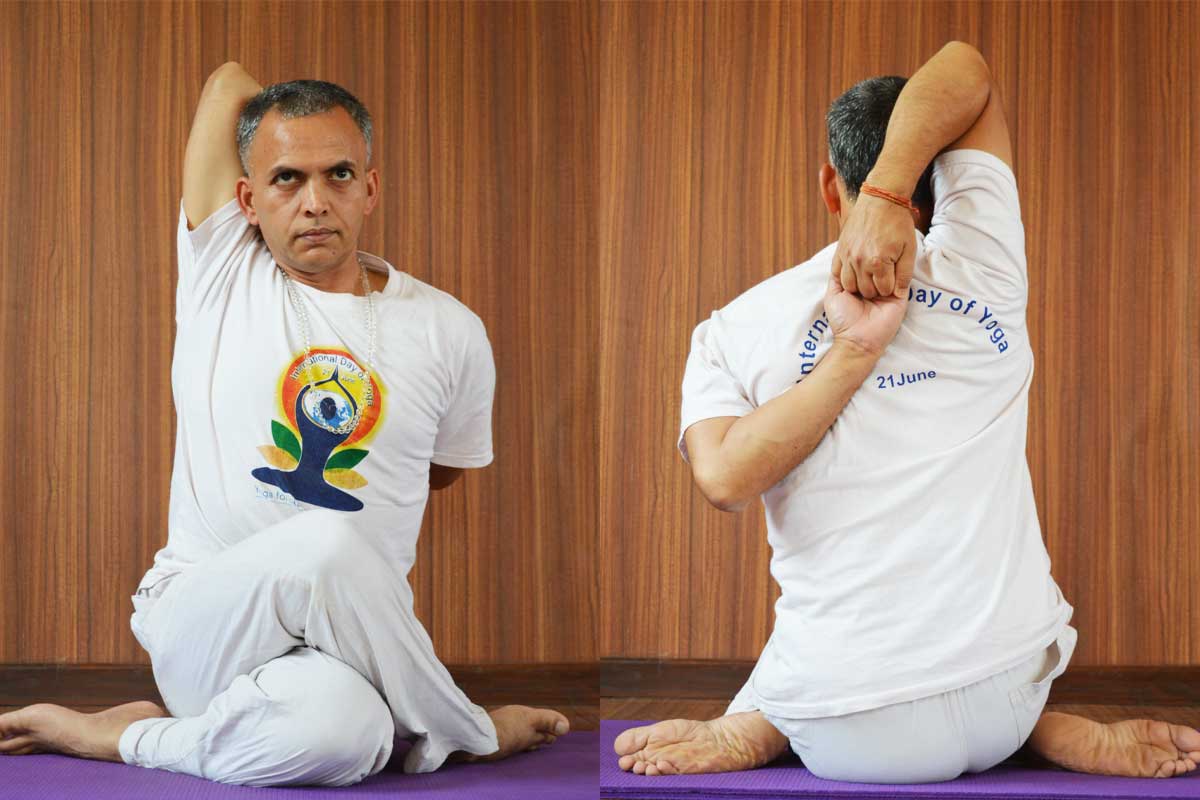GOMUKHASANA MEANING, STEPS, BENEFITS AND PRECAUTIONS
18 Nov 2020 HYN Himalayan Yoga Academy

Chakras : Sacral Chakra (Swadisthana Chakra) , Root Chakra (Muladhara Chakra)
Gomukhasana is a seated yoga posture that stretches several parts of the body simultaneously, including the ankles, hips, thighs, shoulders, underarms, triceps and chest. The name comes from the Sanskrit, ‘Go’means “cow,” mukha, means “face,” and asana, meaning “pose.”It gives good cross-stretch in chest muscles.
Gomukhasana is one of the classical yoga poses explained in Hatha Pradipika. The concept of static stretching in the practice of asanas in the Curriculum of Classical Hatha Yoga is helpful for the stabilization of the muscles without creating the strong forces of the resistance by the joints in the body because of the use of isometric contractions.
The asana, whose name literally translates into Cow Face Pose, has helped a lot of people who are fighting a variety of conditions such as diabetes, back and shoulder issues, and sexual disorders.This is one of the best asana to restore symmetry and postural health. It is wise to have this in your practical Yoga Training Session. The final position of the pose assumes the shape of the face of the cow, hence it is called as Cow face pose.
How To Do Gomukhasana :
- Sit in SamasthithiEven though Gomukhasana is a beginner’s and easy yoga pose, it’s better to do it step by step. So, the steps of Gomukhasana are:Exhaling bend the right knee and place it on the left knee so that the right sole touches the left hip, Inhale. Exhaling bend the left knee so that, left sole touches the right hip.
- Inhaling raises the right arm and interlocks the fingers with the left hand from a backside.
- Sit straight and keep your back straight, and legs forward.
- Now bend your left leg gently and place it under your right hip.
- Then gently bend your right leg and cross it over your left leg. Your knees should be placed close and on top of each other.
- Keep your head and back straight while practicing it.
- Now bend your left hand and slowly place it behind your back from downwards.
- Then bend your right hand and also place it at your back from upwards (over your right shoulder).
- Then stretch your right hand downwards until it reaches your left hand. This might not be easy for people who are not flexible but you’ll learn to do it gradually.
- Now hold this pose for 30 to 60 seconds.
Anatomy
Gomukhasana benefits the following muscles and hence can be included in yoga sequences with the corresponding muscle(s) focus:
Arms and Shoulders, Middle Back, Upper Back, Biceps and Triceps, Hamstrings, Hips Knees Pelvic Quadriceps
Benefits of Gomukhasana
- Gomukhasana can relieve your anxiety and stress and make you a better, healthy person. The rhythmic breathing patterns that are associated with this asana can offer you great mental and emotional benefits.
- Stretches your shoulders, thorax, ankles, triceps, and thighs
- Makes your back flexible
- Relaxes your body and mind
- Helps people with diabetes by enhancing your kidneys
- Reduces anxiety and stress if practiced regularly
- Helps in pressure relief; Performing Gomukhasana on a regular basis can help the practitioner to attain the perfect posture. This asana can stimulate the spine, chest muscles and shoulders for improving the body’s natural posture.
- Gomukhasana can prove to be extremely helpful in curing sexual ailments by stimulating blood flow and easing stiffness from lower parts of the body. It also helps in relieving stress.
- Makes your shoulders loosen up; cure stiff shouldersThis asana induces a deep state of relaxation.
- Brings the peace of mind and serenity, concentration.
- Helps in relieving the stress and the tendencies of the anxiety.
- Good for improving the strength and flexibility of the shoulder joints through the actions of deltoids and rotator cuffs. This helps in preventing the drooping and frozen shoulders.
- Strengthens the spinal column and relieves the back and neck pain.
- Expansion of the chest enhances the lung capacity.
- Stimulates the peristalsis and relieves the digestive disorders.Promotes the range of motion of the hips joints and the flexibility of the muscles in the pelvic girdle.
- Promotes the health of the reproductive organsBrings the good postural health;
- The neck and the lower back the prominent sites of the parasympathetic nervous systems, This pose particularly brings the elasticity in these two regions which is helpful bring the deep state of relaxation and hence it helpful in the reduction of the blood pressure. It makes the preparation of the mind to the practice of meditation.
Contraindications and limitations
It is not advised for the people with the chronic injuries of the knees and shoulder joints.
Release your hands, and unfold and straighten your legs to come back to the starting position.
Preparatory poses for Gomukhasana
Try practicing these yoga poses before doing Gomukhasana to make your body prepared for Gomukhasana.
Virasana
Baddha Konasana
Supta Baddha Konasana
Supta Virasana
Upavistha Konasana
Supta Padangusthasana
Badha Konasana (Bound Angle Pose)
Virasana (Hero Pose)
Upvistha Konasana (Wide-angle seated forward bend)
Supta Virasana (Reclining hero pose)
Supta Padangusthasana (Reclined Big Toe Pose)
Supta Baddha Konasana (Reclined Bound Angle Pose)
Precautions to take while doing Gomukhasana
Please take care of these things before and while doing Gomukhasana.
Avoid practicing Gomukhasana if you’ve back injury.
You should always practice yoga on an empty stomach only.
If you’ve knee pain, neck pain, or shoulder pain, then don’t practice it.
If you can’t clasp your fingers then just stretch your hands at the back. With time, you’ll become flexible enough to practice Gomukhasana perfectly.
You should practice this yoga pose under the guidance of a yoga instructor.
So guys, this was all you needed to know about Gomukhasana. Gomukhasana is very beneficial and a great yoga poses for everyone if practiced daily.
